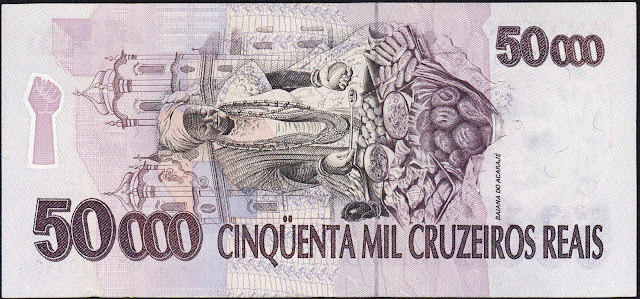Brazil Banknotes 50000 Cruzeiros Reais banknote 1993 Baiana
Central Bank of Brazil - Banco Central do Brasil
Obverse: Portrait of Baiana at right. Symbols of Bahia at center: pomegranate, grape bunches, cashew nut, fish, lamb, carved ivory tusk, hand is showing a fig sign (In Brazil this sign is known as "figas", and symbolizes wishes of good fortune) and a symbol of the faith - the dove of the Holy Spirit. Inscription: "God Be Praised" (Portuguese: DEUS SEJA LOUVADO).
Reverse: Baiana selling Acaraje on the streets of Bahia and main facade of the Church of Nosso Senhor do Bonfim at the background. You’ll find the beautiful Baianas everywhere in the city of Salvador with their tabuleiros (trays and tables) and selling their quitutes (traditional AfroBrazilian dishes). The delicious and traditional acarajes (a fritter of black-eyed peas fried in dendê oil).
Watermark: The Effigy of the Republic of Brazil (Portuguese: Efígie da República) is used as a national personification, both in Brazil and in Portugal, symbolizing the Republic.
See-through register: Hand is showing a fig sign.
Colors: purple, black, yellow.
Size: 140 x 65 mm.
Printer: Casa da Moeda do Brasil (CMB).
Brazilian Currency Banknotes - Brazil Paper Money
August 1993 Monetary Reform: 1 Cruzeiro Real = 1000 Cruzeiros
1993 Overprint "Cruzeiro Real" Provisional Issue
100 Cruzeiros Reais on 100000 Cruzeiros
500 Cruzeiros Reais on 500000 Cruzeiros
1993-1994 Regular "Cruzeiro Real" Issue
1000 Cruzeiros Reais 5000 Cruzeiros Reais 50000 Cruzeiros Reais
Baianas selling Acarajé
Baiana of the acarajé (or simply baiana) are what the women who dedicate themselves to selling acarajé (small cakes made of black-eyed beans fried in palm oil) and other delicacies of Bahia’s cuisine. These are hard working women, who after much struggle, were able to legally register their profession with the public authorities. They are one of the best-known typical characters of Brazil, and their presence is mandatory in the samba schools of the country.
November 25th is the "National Day of Baianas Selling Acarajé" in Brazil and they truly deserve the official title of National Treasures!
Acaraje
Acarajé is the most popular street food in the north eastern state of Brazil, Bahia. The recipe for acarajé was introduced to Bahia by slaves who came from Nigeria during the colonial period. In Nigeria acarajé is named Akara, and the women who sell it call out "Akara je", which means "Come and eat Akara" in Yoruba. So when freed Nigerian slaves started to sell acarajé on the streets, they used the same technique and Brazilians assumed that they were selling acarajé.
Acarajé is made with black-eyed peas, garlic, ginger and salt, then deep fried in dende - a reddish oil from the palm fruit. When done, they are split in half and fillled with vatapá, caruru, fried shrimp, salad and pepper. Brazilians modified the recipe from Nigeria a little and started to fill the acarajé with other afro-Brazilian foods. In Nigeria, none of the Brazilian accompaniments are served; just the bean cake is eaten, fried with palm oil or vegetable oil.
Acarajé are served on the streets by women who call themselves baiana do acarajé. They wear traditional clothes, white flowing dresses, sometimes turbans and colorful necklaces related to the rituals of the Afro-Brazilian religion Candomblé. Many of the Baianas dress in white, "the white of Oxalá". Oxalá is the supreme Divine Being in the Afro Brazilian religion of Candomblé that many of them belong ("Oxalá is the Supreme Father. The Orixá of peace, of balance, of fraternity, of union. Symbolized by white, by purity.") White the color of peace. In Nigeria, however, there is no ceremony and the women who sell Akara wear whatever they like. Nowadays, these baianas sell acarajé as a way of life and it’s something that helps to sustain their families.
In 2004, acarajé was declared part of Brazil's heritage culture in the region of Bahia. It's one of the most important symbols of the culture of Bahia and it's enjoyed by all types of tourists. They are delighted by the taste, color and relaxing way of eating acarajé on the streets.
Church of Nosso Senhor do Bonfim, Salvador
The Church of Nosso Senhor do Bonfim (Portuguese: Igreja de Nosso Senhor do Bonfim) is the most famous of the Catholic churches of Salvador, in the State of Bahia, Brazil. It was built in the 18th century on a hill in the Itapagipe Peninsula, in the lower town of Salvador. The church is the subject of intense religious devotion by the people of Salvador and is the site of a famous celebration held every year in January (Festa do Senhor do Bonfim).

